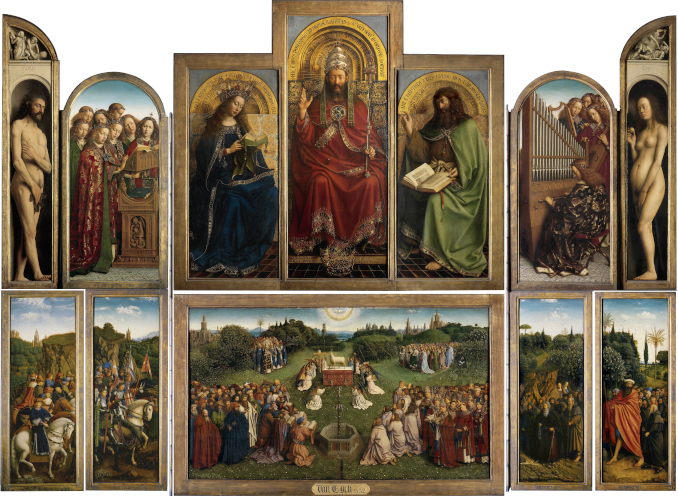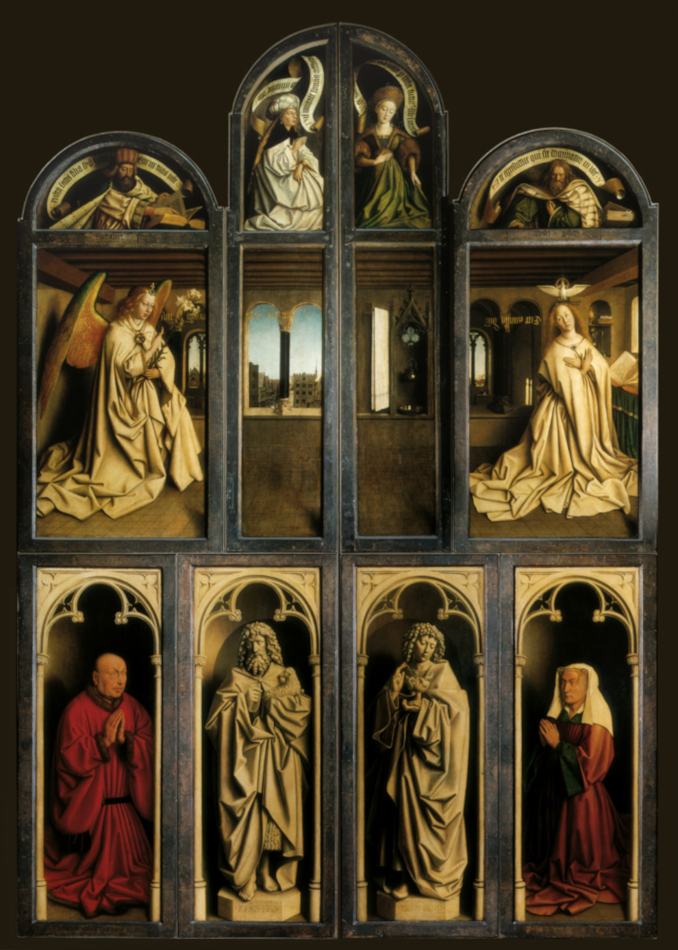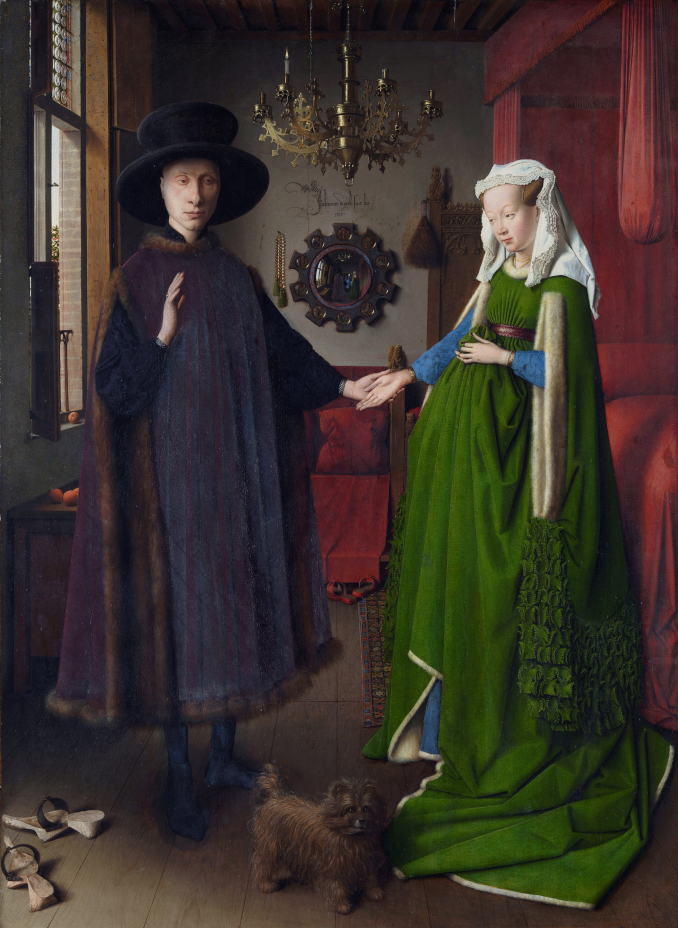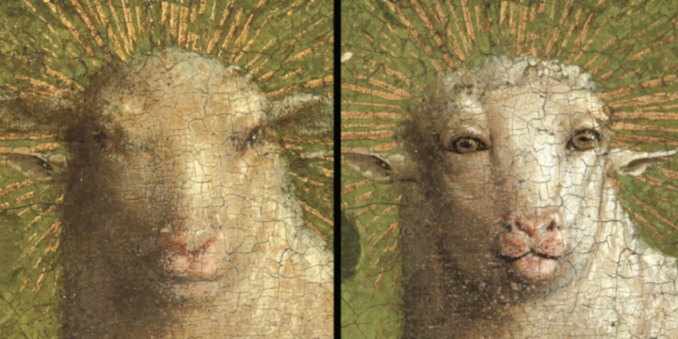
The Ghent Altar or An Adoration of the Mystic Lamb. Inside panels. Photo credit: Wikimedia Commons, Public domain.
The most stolen artwork ever has been restored to its original glory
By Nina Heyn – Your Culture Scout
When brothers Hubert and Jan van Eyck started painting panels of a commissioned altar some time in 1420’s they would have never imagined how many upheavals, thefts, relocations and changes their work would undergo over centuries. The altar is considered one the first major oil paintings in Western art, heralding Renaissance’s pivot towards realistic rendering of nature and human individuality. It has been revered as one of the world’s masterpieces of all times, which is one of the reasons it is also the most stolen art pieces ever. Looters, thieves, soldiers, collectors, and many leaders, from Napoleon to Hitler, have lusted after it, and tried to take its possession.

The Ghent Altar or An Adoration of the Mystic Lamb. Outside back panels. Photo credit: Wikimedia Commons, Public domain
The altar is a multi-picture design of twelve wood panels. The six upper panels feature in the center of God the Father (or Christ the King – a crowned, bearded central figure), Virgin Mary and John the Baptist. The side panels have images of angels playing music and, on the outermost panels, the first humans Adam and Eve. The central painting on the bottom half is an elaborate outdoor scene of groups of people – soldiers, sinners, saints, priests, women – all gathered around the central figure of a lamb. From this image the altar derives the name of An Adoration of the Mystic Lamb. This lower part of the altarpiece would be closest to the eyes of seated worshippers – a panorama of the society with all the splendor of clothing, weapons, jewelry, horses and realistically rendered plants. When all the panels are closed (the inner panels would be displayed for feasts and important masses), you can see equally intricate fronts, decorated with full size portraits of the altar’s donors (Ghent’s mayor and his wife), paintings of angels, and figures of saints rendered as an optical illusion of sculpture. Jan van Eyck was a master of optical illusions as evidenced for example by the mirror in The Arnolfini Portrait .

Jan van Eyck. The Arnolfini Portrait. 1434. National Gallery London. Photo credit: Wikimedia Commons. Public domain
The altar is a culmination of his skill, technical knowledge about optics and the new medium of oil paint, as well as his knowledge of people, landscapes and nature, gathered from his extensive travels throughout Europe and perhaps even Middle East. It’s no wonder that the Ghent altar has been a focus admiration and envy for centuries. As soon as opportunities arose, it also became a commodity to be traded or looted.
The altar’s first move happened soon after its official installation in 1432 at a church in the city of Ghent. For security reasons, it was relocated to its present location of St. Bavo’s Cathedral in Ghent. An ornate altar frame that carried names of its painters was destroyed during the Protestant Reformation (16th c. schism between the power of the Catholic Church and new Christian movements of Lutheranism, Calvinism etc.).
In the 18th century, the nakedness of Adam and Eve was deemed offensive to the Emperor Joseph II who ordered them covered, and by the 19th century even that was not sufficient so these panels were replaced entirely by a “more decent “version.
Napoleon and his army pioneered a policy of conquering not only lands and its people but also the works of art. The altar was high on the list of art to be seized as soon as the army entered a city – together with masterpieces from Italy, Germany and Spain. The altar was looted from Ghent and displayed at the Louvre only to be returned after the Napoleonic army’s defeat at Waterloo. In 1816 the altar’s integrity was broken again, when an English collector Edward Solly purchased several of the side panels for an equivalent of about $4000 in current value, soon to be re-sold to the King of Prussia. In 1822 a fire damaged parts of the altar that were still in Belgium. During WWI, some panels were looted by German soldiers but, as part of after-war reparations, they were returned together with the panels originally bought by Solly. This reparation, together with other heavy restitution penalties imposed by Treaty of Versailles, was bitterly resented in the 1930’s Germany. When the second war came around, the altar made a shortlist of pieces to be taken again.
In 1934, one of the bottom panels (called Righteous Judges) was stolen, and it was never recovered despite intensive searches. Then WWII came and van Eyck’s masterpiece again came under threat. The Belgian government was trying to send the altar into safety of the Vatican (a repository of art that has saved some artwork even during the sack of Rome in 1527). Unfortunately, Italy joined the Axis by then, and it this was no longer a country to hide a work of art from the German army. For a while the altar was stored in the French Pyrenée mountains under a fragile protection of an agreement between Belgium, France and Germany. In 1942 Hitler ordered the altar seized and moved to a Bavarian castle. The greatest danger came to the altar towards the end of the war, when the panels were hidden in an Altausee salt mine together with hundreds of other looted masterpieces. The cache became an object of a tug of war between a zealous Nazi official who was planning to blow up the treasure lest it falls into the Allies hands, and some mine workers who were trying to sabotage this plan. The altar, Michelangelo’s Madonna of Bruges, and other looted treasures were successfully recovered by Monuments Men. The 2014 movie with George Clooney, Matt Damon and Cate Blanchett documents well this effort to save Hitler’s loot from last-minute destruction.
The altar has been undergoing a painstaking restoration since 2012, leading to an unexpected discovery. The central figure of Christ as a lamb has been considered in our times to be an original, but the restoration has revealed that sometime in the early 16th c. the lamb has been substantially altered. Since this is not a portrait of a farm animal in a meadow but an allegory of Christ’s suffering, the original face was painted with human eyes and gazing directly onto a viewer. This apparently proved too much of a pressure for the worshippers, and the lamb has been re-painted. For ages the viewers have been puzzled by this apparent third ear of the lamb – now we know that this was a remnant of the original composition. Only now, during the latest restoration of the panel this overglaze has been discovered and removed. The transformation is remarkable, creating quitre a stir in social media.

Ghent Altar. An Adoration of the Mystic Lamb. St. Bavo’s Cathedral. Lukas-Art-in-Flanders. Restoration detail. Photo credit: Wikimedia Commons, Public domain
Belgian Royal Institute of Cultural Heritage has just completed an eight-year long restoration of the altar. To celebrate this event, the Museum of Fine Arts (MSK) in Ghent will open between Feb. 1- April 30, 2020 an exhibition entitled Van Eyck, an Optical Revolution. Only about twenty paintings by van Eyck have survived to our times. More than a half of them, as well as the newly restored back panels of the altar, will be displayed together at the exhibition. Afterwards, the restored panels will return to their rightful place at the St. Bavo’s, hopefully not to move again. This would be a major achievement considering how many times this piece, weighting over 1,5 ton, has been broken up and moved around.
Catherine will be visiting this exhibition soon and she will share her impressions of this lifetime opportunity to see the masterpiece of European art restored to its glory almost 600 years after it was created.
